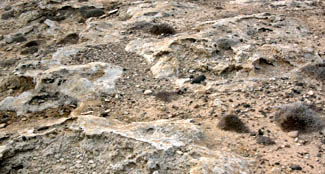A plant needs loose soil to easily access water and nutrients. In addition, in loose soil the roots can grow more freely. That’s why it’s always important to prepare the soil properly before burying a seed.

However, when a soil previously saturated with water goes through a long drought, it tends to harden too much. If, in addition, the ground receives to the constant action of different loads, it’s compacted and becomes even harder.
Under these conditions it’s impossible for a plant to survive. And when the soil lacks of organic matter and other nutrients, it’s even more difficult for something green to grow there.
Fortunately that’s not a problem without a solution. Following some useful advices, it’s possible to return the loose and fertility to the more difficult soil. Today you’ll learn how to break up hard ground like a pro.
What is Hard Ground?
A hard ground is the result of compaction of soil particles. The absence of empty spaces between particles provides greater resistance to the ground.
Compaction occurs when a wet soil receives different loads. Then, when it dries, it becomes even harder.
Step by Step Guide of How to Break Up Hard Ground
If you’re thinking of planting something new in your garden, a hard ground is a big obstacle. Plants need soils with enough empty spaces to develop and grow. If you bury a seed in too compact soil, you’re unlikely to succeed.
However, there’s nothing to worry about. With the right tools and techniques, you can soften the hardest ground in a short time. Here’s the step by step guide:
Moisten the Ground
As stated at the beginning, the soil reaches its maximum hardness when it’s completely dry. Therefore, returning lost moisture will help release its particles.
To do this, connect a hose to the nearest water faucet and water the hard ground until it becomes darker.
Wait Some Minutes
Let excess water drain through the particles and empty spaces fill with air. If you work on a completely saturated soil, you’re likely to end up doing a great mess.
Break Up the Ground
There’s a wide variety of different tools that you can use to remove the outer layers of hardened soil. The most commons are:
- Peak shovel
- Garden rake
- Garden trident
- Tiller
A peak shovel is useful for deep penetration. It has a point tip and a flat tip. The point tip serves to break the ground, concentrating all the force on the same point. Instead, the flat tip serves to remove loose soil. It’s also useful to dig trenches.
It works like a hammer. You must hold the hardwood shaft tightly. Then lift the tool and push with one or both arms. The impact of the peak breaks the hard ground.
Usually, people use garden rakes to remove dried leaves from their gardens. However, steel garden rakes also serve to break up the surface of the hard ground. It works like a broom.
Sharp points of the rake break the ground as they move over it. A garden trident serves the same purpose. However, it’s a much smaller tool and you use it to break up soil around small crops.
A tiller is a broom-like tool, but instead of a brush, it uses rings with peaks that revolve around the same axis. The action of the peaks removes the hard ground.
Add Organic Matter
When you’re done breaking up the ground, add humus to the ground to attract earthworms, fungi and bacteria. They’ll help nourish the soil and break up deeper hard particles.
Conclusion
As you can see, breaking up hard ground isn’t as difficult as you thought. Make sure you have the right tools to make the job much easier.
Remember that you must moisten the soil, not saturate it. Adding more water than required, will turn the ground into a lot of mud. Follow these tips carefully so that everything goes well.
Leave a Reply
You must be logged in to post a comment.